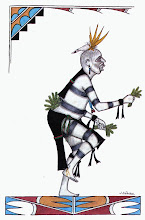Update
-
Dear Friends, We are excited to notify everyone that we have a new site to
visit. This is http://www.sacredbreathlodge.com which is the literal
translation...
Wednesday, July 21, 2010
Sunday, June 6, 2010
Quoted with deep admiration and respect, click on his name, linked to the greater body of his work:
Search Amazon.com for coyote medicine
offered by Lewis Mehl-Madrona, M.D., Ph.D.
"...Native American medicine has been practiced on the North American continent for at least 10,000 years. When Europeans arrived in North America, Native people of this continent were a healthy lot. Plagues and epidemics from Europe soon changed that, but do not mitigate against the effectiveness of Native American methods for attaining long-term survival and avoiding chronic disease. Conventional medicine has lost this wisdom for transforming illness into health through mind-body-spirit integration - a fundamental concept among Native North Americans and most of the remainder of the indigenous world. Conventional psychotherapies have also fallen short of their ability to transform people's lives. They have parceled out therapeutic time in hourly increments in frequencies of once or twice weekly. Weekly one-hour appointments or even yoga classes before work allow us to address only our most critical and immediate concerns. The time needed for inner exploration, for personal transformation, and for the exploration of how personal issues, nutrition, family problems or spiritual matters affect our health is sorely lacking.
Conventional therapies have neglected opportunities to facilitate a profound change within a short period of time. They have also ignored the power of ceremony and ritual in treatment. Ceremonies couple the patient's intention to heal with the power of belief and faith in the ceremonial process. They lead to peak experiences that kindle insight into our condition and increase our belief in our own abilities and capabilities. Since medical school graduation, I have been working to integrate the thoughts and techniques of traditional Native American healing elders with more common behavioral medicine techniques and psychotherapies. I have wanted to find the most effective and most aesthetic way for me to midwife people's personal transformations and healings. To improve my approach, I interviewed a number of Native American healers to learn how they conceptualized their work and how they thought it could be translated into modern American culture.
In organic and biochemistry, an energy of activation is required to initiate a reaction. Once initiated that reaction may proceed irreversibly to completion without much further energetic input. Without sufficient energy of activation, the reaction never occurs. A cake without sufficient energy of heat remains mush. A minimal level of heat is needed to actually cook the cake (transforming the internal arrangements of its molecules). The healers loved these comparisons to chemistry, and reflected upon how nature is the same at every level. In systems science, we say that each layer is isomorphic to the other.
The healers related that they typically stayed with the sick person until the job was done. They rarely helped more than one person at a time, and people often traveled great distances to see them. These great distances necessitated an intensive approach, since the journey from home to the healer could not be made many times.
The healers would concentrate their work over a number of consecutive days with multiple hours spent each day on healing. Ceremonies often took place every night. Lakota healers would do sweat lodge ceremonies at night, sometimes followed by yuwipi ceremonies. Dineteh healers would perform nightly chants lasting as long as ten days as in the Blessing Way or the Coyote Way. When sufficient progress had been made, the person would be sent home with instructions to return at a later date for further treatment. Because their healing was more directive, their patients would leave with specific instructions for tasks to complete during the interval apart.
The traditional healers emphasized how they helped people become aware of their inner world - their anger, sorrow, bitterness, rage, and hatred, so that it could move again. They pointed out how modern American culture teaches people to ignore their inner world and their feelings. Children are taught in school to ignore their body needs for elimination until it is convenient for the teacher. They are taught to ignore their wish to play until scheduled recess. Civilization, as it is now constructed, requires a level of ignoring emotions for smooth functioning that the traditionals found sad.
Traditional healers pointed out how strange it is for a secretary to be unable to take time off if overcome by sadness from a tragic case history she was typing. In this example, they thought it was odd that the bosses could imagine that a human being could type a document without entering into the story that the document conveys. They reflected on how emotions got in the way of efficiency in the modern world. They related how their society used to be less hurried. Hurry has become the watchword of modern society, since the faster we go, the more money we make.
In the days before modern pharmaceuticals, rest was a key ingredient of any therapy. Healing may best begin by putting the client to bed. This disturbs daily routines and breaks old habits. It allows the body's repair mechanisms to take over from the defense mechanisms; the parasympathetic nervous system to calm down the sympathetic nervous system.
Traditionals mentioned the importance of a number of ceremonial procedures, including purification ceremonies, which are also important for the inner life. They see becoming well as a journey - a journey that takes time."
Subscribe to:
Comments (Atom)
About Me

- The Tree of Life Foundation
- Kansas City, Missouri, United States
- Having followed many Paths, Teachers, Traditions & Leaders, I now describe myself as an Elder, Caucasian, Inka, Buddhist, Dervish Medicine Man, struggling to integrate power and humility, or, more simply, how to get out of the Way. Now, my Guru is my bulldog, Charlie, the Bonnie Prince.
